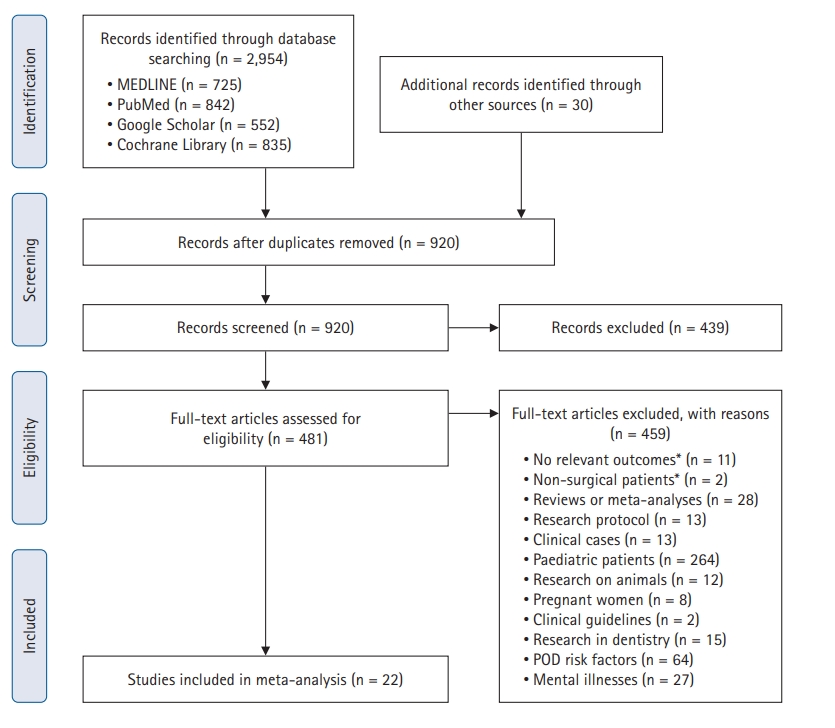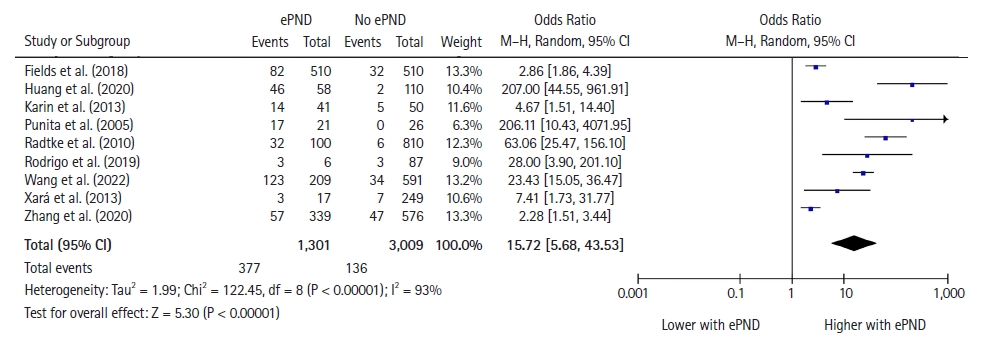 |
 |
| Korean J Anesthesiol > Volume 76(5); 2023 > Article |
|
Abstract
Background
Methods
Results
NOTES
Data Availability
Availability of data: template data collection forms, data extracted from included studies, data used for all analyses on other data are available from the corresponding author on request.
Author Contributions
Valery V. Likhvantsev (Conceptualization; Writing ŌĆō original draft; Writing ŌĆō review & editing)
Giovanni Landoni (Conceptualization; Writing ŌĆō original draft; Writing ŌĆō review & editing)
Levan B. Berikashvili (Formal analysis; Writing ŌĆō original draft)
Nadezhda V. Ermokhina (Formal analysis)
Mikhail Y. Yadgarov (Formal analysis; Writing ŌĆō original draft)
Yuki Kotani (Formal analysis; Writing ŌĆō original draft)
Kristina K. Kadantseva (Formal analysis)
Dmitry M. Makarevich (Formal analysis; Writing ŌĆō original draft)
Andrey V. Grechko (Formal analysis; Writing ŌĆō original draft)
Supplementary Materials
Supplementary┬ĀMaterial┬Ā1.
Supplementary┬ĀTable┬Ā1.
Supplementary┬ĀTable┬Ā2.
Supplementary┬ĀFig.┬Ā1.
Supplementary┬ĀFig.┬Ā2.
Supplementary┬ĀFig.┬Ā3.
Supplementary┬ĀFig.┬Ā4.
Supplementary┬ĀFig.┬Ā9.
Fig.┬Ā1.

Fig.┬Ā2.

Fig.┬Ā3.

Table┬Ā1.
| Study | Design | ePND criteria | Scale type | Sample size, ePND (%) | Mean age (yr) | Sex, male (%) | ASAŌēź 3, (%) | Volatile anesthetics (% of patients) | Operation time (min) | Anesthesia time (min) |
|---|---|---|---|---|---|---|---|---|---|---|
| Assefa and Sahile (2019) [22] | PO | RASS Ōēź +1 | Motor | 306, 97 (32%) | 44 | 47 | 2.6 | N/D | 65.5 | N/D |
| Fields et al. (2018) [23]* | Matched case-control | RASS score of +3 or +4 or the administration of haloperidol | Motor | 1020, 510 (50%) | 63 | 73 | N/D | 44 | 138 | N/D |
| Guti├®rrez et al. (2019) [24] | PO | CAM | Cognitive | 93, 6 (6%) | 73 | 39 | N/D | N/D | N/D | N/D |
| Hesse et al. (2019) [25] | PO | CAM-ICU | Cognitive | 626, 125 (20%) | 59 | 60 | 43 | 98 | N/D | 116 |
| Huang et al. (2020) [26] | PO | Nu-DESC | Cognitive | 168, 58 (35%) | 72 | 53 | 55 | 100 | 141 | N/D |
| Kim et al. (2015) [27] | RO | SAS Ōēź 5 | Motor | 488, 48 (10%) | 62 | 82 | 6.2 | 92 | 109 | 146 |
| Lepouse et al. (2006) [28] | PO | SAS Ōēź 5 | Motor | 1359, 64 (5%) | 51 | 54 | 21 | 64 | 76 | N/D |
| Munk et al. (2016) [29] | PO | RASS Ōēź +1 | Motor | 1970, 73 (4%) | 60 | 46 | 15 | 11 | 80 | 147 |
| Neufeld et al. (2013) [30] | PO | DSM-IV | Cognitive | 91, 41 (45%) | 79 | 42 | N/D | N/D | 186 | N/D |
| Olbert et al. (2019) [31] | PO | DSM-V | Cognitive | 176, 16 (9%) | 69 | 54 | 30 | N/D | N/D | 130 |
| Sharma et al. (2005) [32] | PO | CAM | Cognitive | 47, 21 (45%) | 77 | 34 | 2 | 100 | 145 | N/D |
| Radtke et al. (2008) [33] | PO | DSM-IV | Cognitive | 154, 21 (14%) | 54 | 60 | 25 | 55 | 75 | N/D |
| Radtke et al. (2010) [34] | PO | Nu-DESC | Cognitive | 910, 100 (11%) | 53 | 53 | 26 | 53 | 79 | N/D |
| Radtke et al. (2010) [35] | PO | RASS Ōēź +1 | Motor | 1868, 93 (5%) | 52 | 51 | 29 | 61 | 84 | N/D |
| Saller et al. (2019) [36] | PO | DSM-V | Cognitive | 543, 22 (4%) | 52 | 55 | 21 | 41 | 97 | N/D |
| Wang et al. (2020) [37] | PO | CAM-ICU | Cognitive | 800, 209 (26%) | 48 | 41 | 3.5 | N/D | 261 | N/D |
| Wiinholdt et al. (2019) [38] | PO | Nu-DESC | Cognitive | 1000, 103 (10%) | 60 | 48 | 20 | 72 | N/D | 141 |
| Winter et al. (2015) [39] | PO | Nu-DESC ╦ā 2 | Cognitive | 1000, 43 (4%) | 58 | 40 | 9.3 | N/D | 93 | 166 |
| Wu et al. (2021) [40] | PO | CAM-ICU | Cognitive | 228, 57 (25%) | 39 | 43 | 13 | 82 | N/D | N/D |
| Xar├Ī et al. (2013) [41] | PO | RASS Ōēź +1 | Motor | 266, 17 (6%) | 56 | 40 | 16 | N/D | 90 | N/D |
| Yu et al. (2010) [42] | PO | Three point scale | Motor | 2000, 426 (21%) | 42 | 43 | 0 | 68 | N/D | N/D |
| Zhang et al. (2020) [43] | PO | ąĪAM-ICU | Cognitive | 915, 339 (37%) | 71 | 60 | 0 | 31 | 203 | N/D |
*This case-control study was excluded from the occurrence rate of ePND and mortality rate calculations of the included studies overall. ePND: early postoperative neurocognitive disorders, SAS: Riker SedationŌĆōAgitation Scale, ASA: American Society of Anesthesiologists, RASS: Richmond Agitation-Sedation Scale, CAM: Confusion Assessment Method, CAM-ICU: Confusion Assessment Method for the Intensive Care Unit, Nu-DESC: Nursing-Delirium Screening Scale, DSM: Diagnostic and Statistical Manual of Mental Disorders, RO: retrospective observational, PO: prospective observational, N/D: no data.
Table┬Ā2.
Table┬Ā3.
ePND: early postoperative neurocognitive disorder, ED: emergence delirium, EA: emergence agitation, POD: postoperative delirium, OR: odds ratio, SMD: standardized mean difference, PACU: post anesthesia care unit, LoS: length of stay. Key; 0: no evidence downgrade, ŌłÆ1: serious limitation, ŌłÆ2: very serious limitation, +1: evidence upgrade. Baseline evidence level for studies of prognostic factors: high. *Therapy for early postoperative neurocognitive disorders in the ePND group could potentially decrease POD rates.
References
- TOOLS
-
METRICS

-
- 0 Crossref
- 1 Scopus
- 2,187 View
- 122 Download








